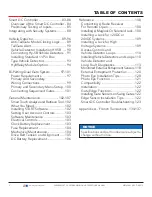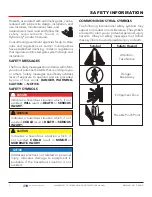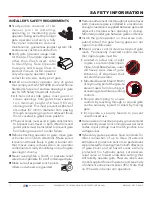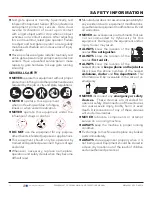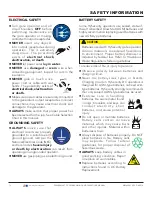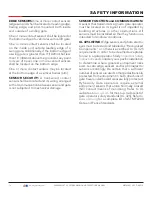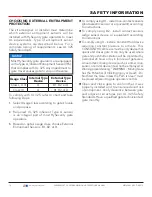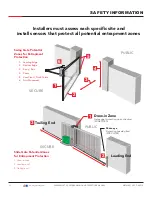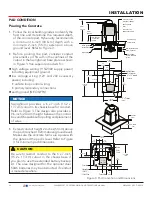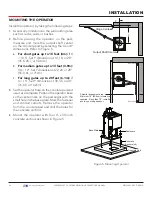
DO NOT charge frozen battery. Battery can
explode. If frozen, warm the battery to at least
61°F (16°C).
ENVIRONMENTAL SAFETY/HAZARDOUS
MATERIALS AND PROPER DISPOSAL
Decommissioning is a controlled
process used to safely retire a piece of
equipment that is no longer serviceable.
If the equipment poses an unacceptable
and unrepairable safety risk due to wear or damage
or is no longer cost effective to maintain (beyond
life-cycle reliability) and is to be decommissioned
(demolition and dismantlement),be sure to follow
rules below.
DO NOT
pour waste or oil directly onto the
ground, down a drain or into any water source.
Contact your country's Department of Public
Works or recycling agency in your area and
arrange for proper disposal of any electrical
components, waste or oil associated with this
equipment.
When the life cycle of this equipment is over,
remove battery and bring to appropriate facility
for lead reclamation. Use safety precautions
when handling batteries that contain sulfuric
acid.
When the life cycle of this equipment is over, it
is recommended that the frame and all other
metal and plastic parts be sent to a recycling
center.
Metal and plastic recycling involves the collection
of metal and plastic from discarded products and
its transformation into raw materials to use in
manufacturing a new product.
Recyclers and manufacturers alike promote the
process of recycling metal and plastic. Using
a metal and plastic recycling center promotes
energy cost savings.
EXTERNAL ENTRAPMENT PROTECTION
SENSORS
Most HySecurity gate operators are equipped with
a Type A, Inherent Entrapment Sensor (IES). UL 325
Safety Standard compliance requires installation of
external entrapment protection sensors, number
of which, depends on entrapment hazards that
exist at each particular installation.
To comply with UL 325, the following external
sensors may be used:
Contact sensors, such as edge sensors
Non-contact sensors, such as photoelectric eyes
Site designer or installer can choose either
photoelectric eyes, edge sensors, or a combination
of these devices. Whatever devices are used,
protection in both opening and closing directions
of gate travel must be provided.
UL 325 Safety Standard for automatic sliding
gates specifically requires that edge sensors,
photoelectric eyes, or a combination of both
devices be installed to protect against pedestrian
entrapment in BOTH directions of gate travel and
wherever entrapment hazards exist.
PHOTOELECTRIC EYES:
One or more non-
contact sensor (photoelectric eyes) shall be
located where entrapment risk or obstruction
exists, such as perimeter reachable by a moving
gate.
Care shall be exercised to reduce the risk of
nuisance tripping, such as when a vehicle trips the
sensor while the gate is moving.
CAUTION
A contact or non-contact sensor is also required
to protect against possible entrapment if gate
opens to a position less than 16 inches from
any object, such as a post or wall.
SAFETY INFORMATION
15
| www.hysecurity.com
SWINGSMART DC PROGRAMMING AND OPERATIONS MANUAL
MX3640-01 REV. D ©2018





